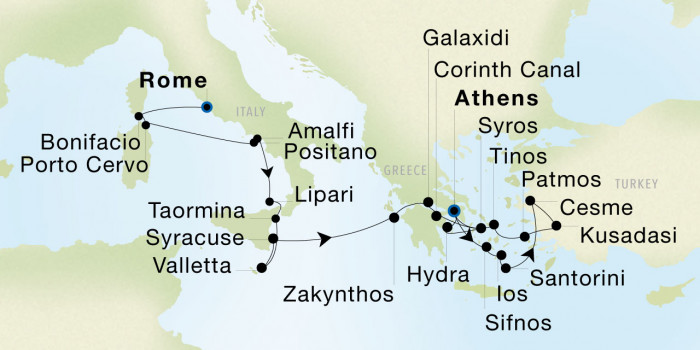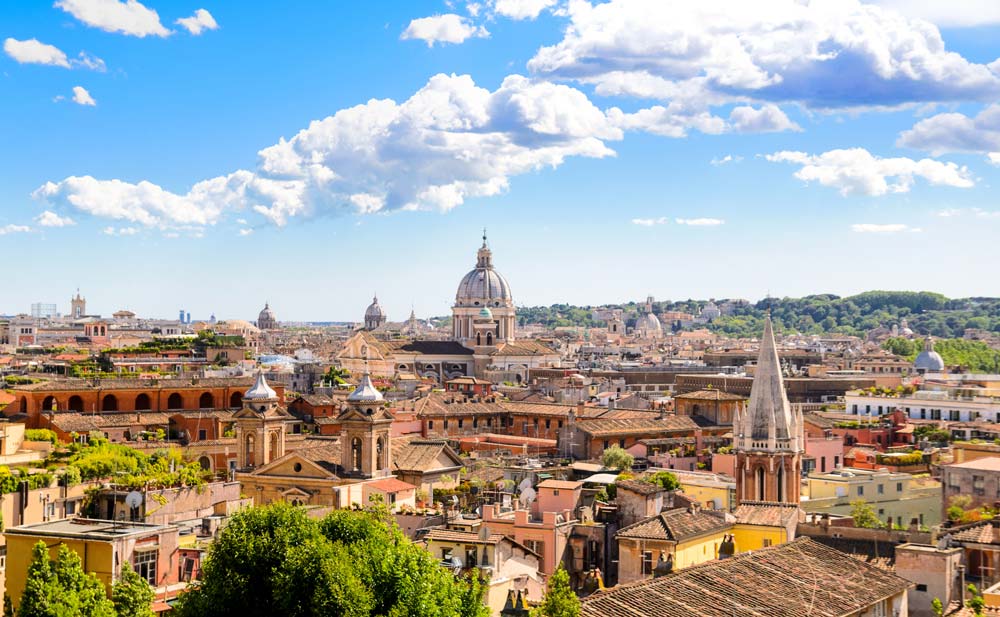
Civitavecchia is a major port located in Rome, primarily utilized for maritime transportation of goods, as well as a fishing port. The commune’s name means “ancient town” and is one of the “Motorways of the Sea” in the Mediterranean, functioning as one of the main links between the mainland of Italy and Sardinia. The ancient name of the port was “Centumcellae,” first mentioned in a letter written by Pliny the Younger in 107 A.D., although scholars debate on whether the name was about the number of rooms of the Trajan Villa, or the number of natural creeks on the coast. Civitavecchia is a part of the Lazio Territory, an area which was confirmed to have social groups since pre-historic times, and the modern town was built over a pre-existing settlement of the Etruscan people in 107-108 B.C.E. (who debated to have founded Rome). In the beginning of the 2nd century, the harbor and town of Centumcellae were simultaneously developed by Emperor Trajan in the territory of Aquae Tauri. As the town became more popular for ships traveling westbound, the Thermal Baths were constructed on the hill of Ficoncella. Centumcellae flourished in the Imperial Age, and by 538 A.D., it had become a Byzantine stronghold. In 728 A.D., it became a member of the Papal States. The Saracens raided Centumcellae many times in the 9th century, prompting Pope Leo VII to have a newer and more secure settlement built by 854. The town, then known as Civita Vetula, was under the rule of several lords, and the Popes temporarily lost control during the French Rule in 1798-1815. In 1870 it entered the Kingdom of Italy. Civitavecchia was severely damaged during WWII, destroying many of the ancient monuments including Forte Michelangelo, which would be rebuilt in the 1950’s. Popular points of interest include the Forte Michelangelo, Terme Taurine, and Cattedrale di San Francesco. There is a wealth of Roman and Vatican architecture and tourists are encouraged to visit many of the museums and take the cultural tours available in this important sea port.
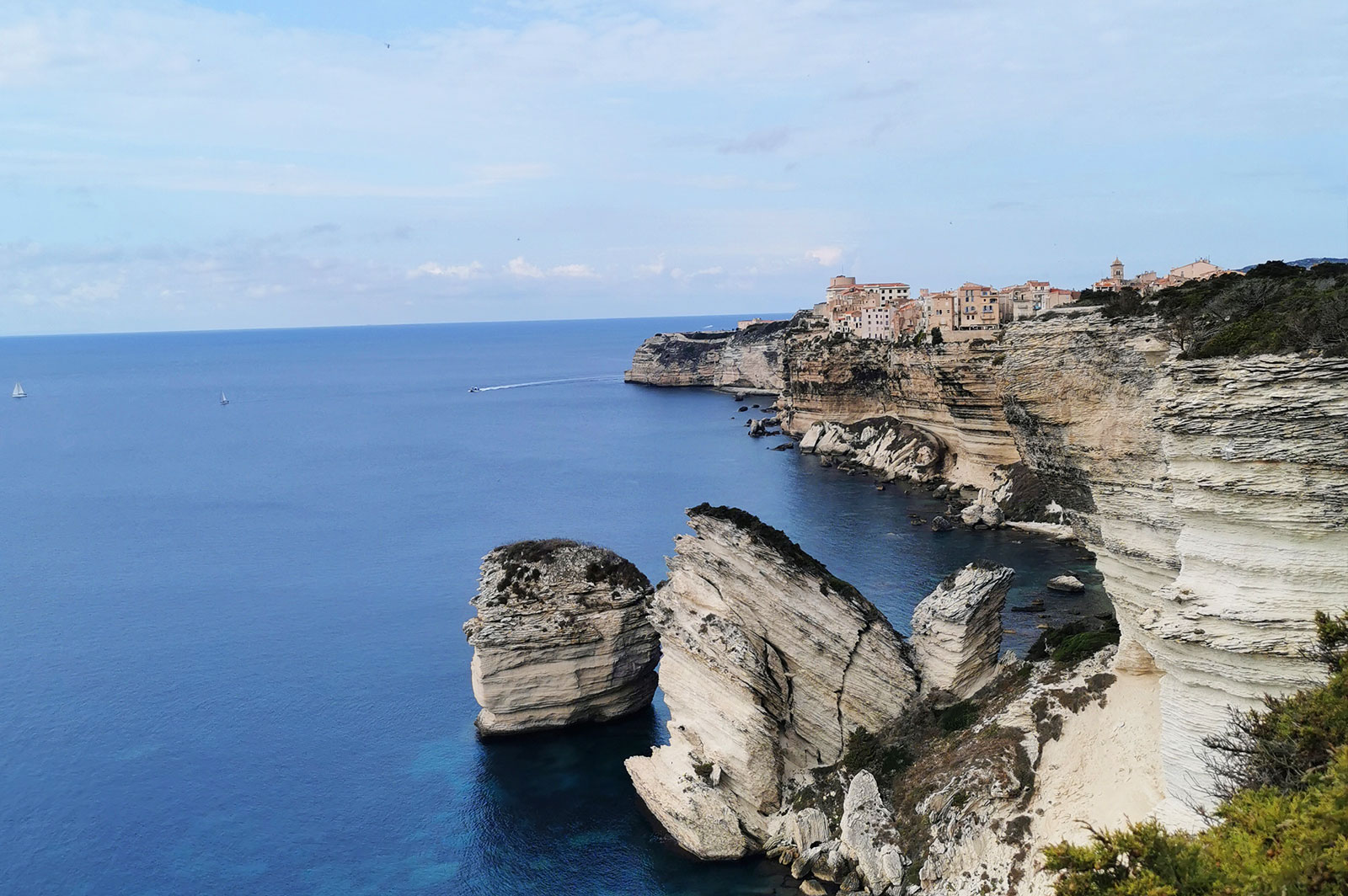
Bonifacio is one of our favorite arrivals! As we approach, the Captain navigates along the limestone cliffs giving guests a sea view of incredible Bonifacio as well as the great Aragon steps leading to the water’s edge. Shortly after the pilot will embark and the Captain will turn the yacht around and back into this very impressive fjord-like marina. This could be one of our highest rated arrivals as the guests always find it both impressive and awe inspiring.
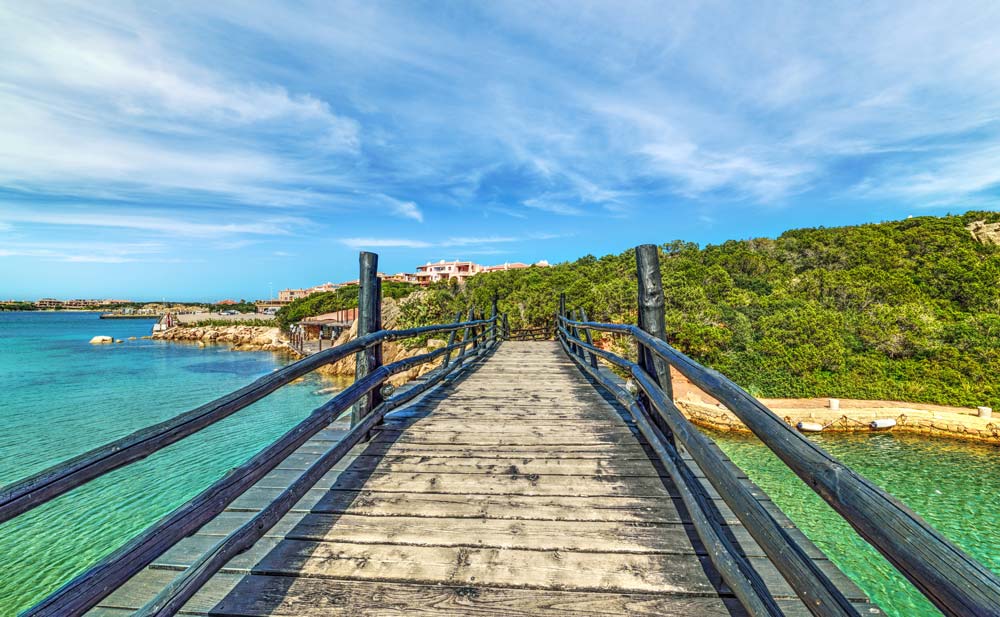
Porto Cervo is an Italian seaside resort in northern Sardinia in an area called the Costa Smeralda (Emerald Coast). SeaDream is most likely the only commercial vessel allowed to call to this amazing port of call. There have been several restrictions navigating and calling to ports within the protected national park zone. The best solution rather than anchoring was to get permission to dock next to the other super yachts “stern to” (backing into the pier using the marina platform to access to the port). The village is the main centre of the Costa Smeralda. It was created by Prince Karim Aga Khan and various other investors. The village houses some amazing boutiques, a newsagent, bars, restaurants and supermarkets. Guests like to visit incredible properties such as Cala di Volpe, Patrizza, Romazzino as well as the Pevero Golf Club for some amazing golf and tennis options. SeaDream’s Land adventure takes guests to all the sights of the Costa Smeralda.

Positano is one of the most picturesque villages along the UNESCO awarded Amalfi Coast (Costiera Amalfitana), in Campania, Italy. The town itself is perched on an enclave on the face of a hill and winds down towards the sea. This incredible setting has been enjoyed by writers, movie stars and millions of tourist each year. John Steinbeck visited in the 50's and stated “Positano bites deep. It is a dream place that isn’t quite real when you are there and becomes beckoningly real after you have gone.” The movie "Under the Tuscan Sun" and several others have been shot on location here. Besides the incredibly romantic atmosphere, it offers excellent shopping, beautiful beaches, hiking trails and a few world recognized and award winning hotels such as Le Sirenuse and Il San Pietro di Positano amongst others. As large coaches cannot navigate down to the pier, only private arrangements are available here. You can book a very nice sedan or van to take you to the neighboring villages or even to Pompeii. As SeaDream anchors just of the pier, you may have the opportunity to access the yachts marina and water toys (conditions and local approval permitting).

Amalfi is a picturesque town in the province of Salerno, in the Campania region of Italy. With its incredible views, it is the central town that makes up the very famous and UNESCO awarded Amalfi Coast (Costiera Amalfitana). Amalfi sports some impressive medieval architecture including; its cathedral of Sant'Andrea (St. Andrew), the church tower, the convent of the Cappuccini, founded by the Amalfitan Cardinal Pietro Capuano. They richly represent the artistic movement prevailing in Southern Italy. From Amalfi, we have created two exciting land adventures for you. One to Scenic Ravello and the other to Fascinating Pompeii. You may also choose to play from the yacht’s marina (Permission and conditions pending) or go on a very scenic hike with one of the officers.
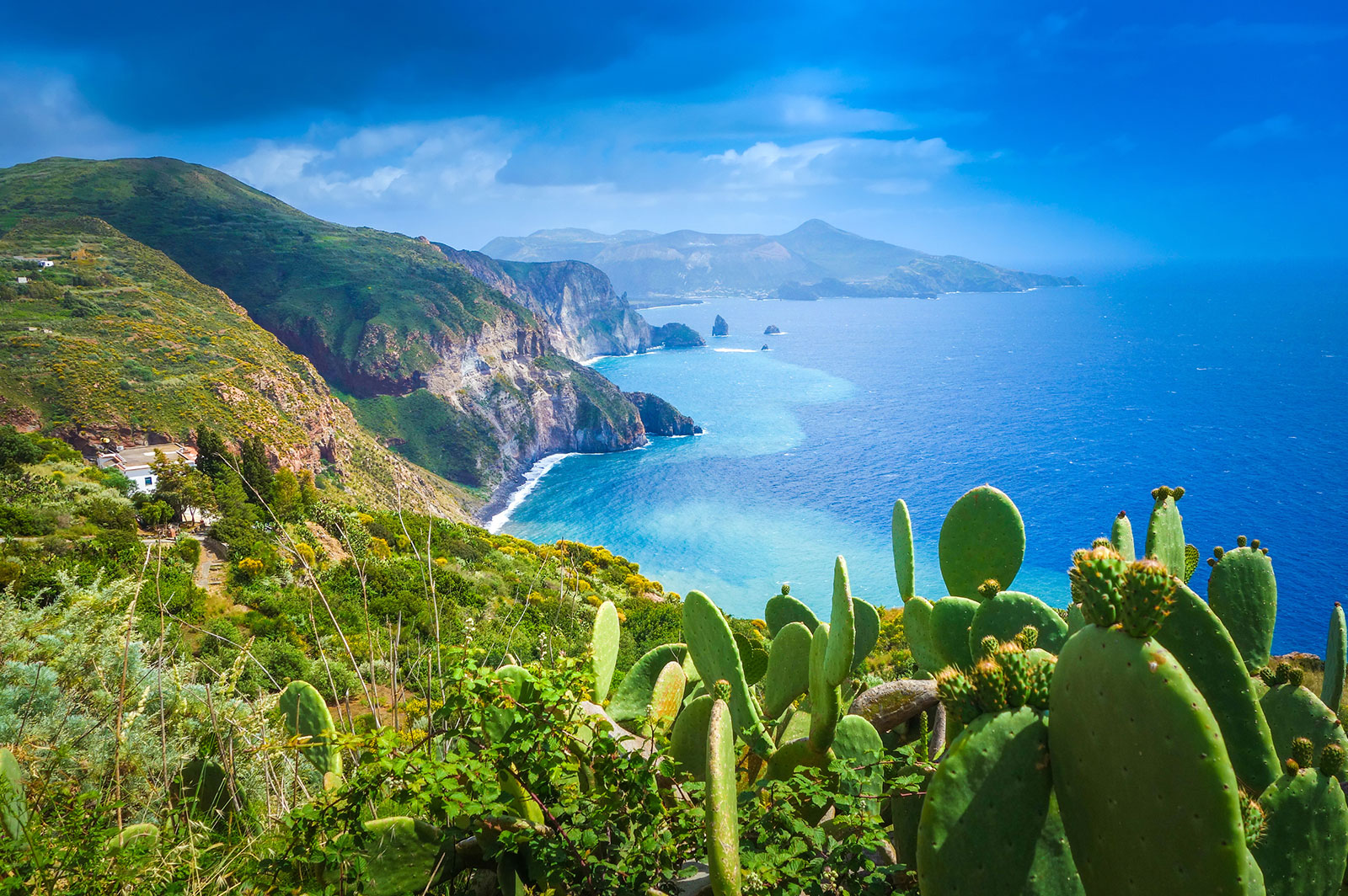
Lipari is one of seven islands of the Aeolian Island group in the Tyrrhenian Sea off the northern coast of Sicily. The charming seaside town boasts a fortified castello and the impressive Aeolian Archaeological Museum. For centuries the world center for pumice production, Lipari has the finest white pumice dust on its beaches. The water off Spiaggia Bianca (White Beach) is as clear as the turquoise waters of the Caribbean, and perfect for exploring with SeaDream’s signature Marina platform. There are also several black sand beaches on the island worthy of exploration. On every voyage that calls on Lipari, enjoy a lovely scenic sailing past impressive Mt. Stromboli, one of the four active volcanoes in Italy.

SeaDream yachts anchor in the bay of Giardini Naxos and offer fantastic views of recently awarded UNESCO Natural Site of Mt. Etna (2013) as well as Taormina perched on the cliffside. Shuttle bus service has been arranged to transport guests from Giardini Naxos to the entrance gate of Taormina town up to Castelmola which provides amazing views of the surrounding areas. Perhaps the “must do” adventure here would be to ascend Mt. Etna with your fellow SeaDreamers. Kindly check the Land Adventure tab for the specifics. Other options include an incredible and authentic feast at the Godfather Villa. As we are anchored and if conditions allow, we will offer water sports both in the morning and in the afternoon.

Established in the 1500s by the Knights of St. John, this fortified city on a hilly peninsula soars between two of the finest natural harbors in the Mediterranean. A UNESCO World Heritage site, Valletta is defined by its sites of historical significance, with architecture dating back to the 16th century. Valletta is a pleasant and charming city to stroll, with little vehicle traffic and lots of stories to be discovered around every corner.
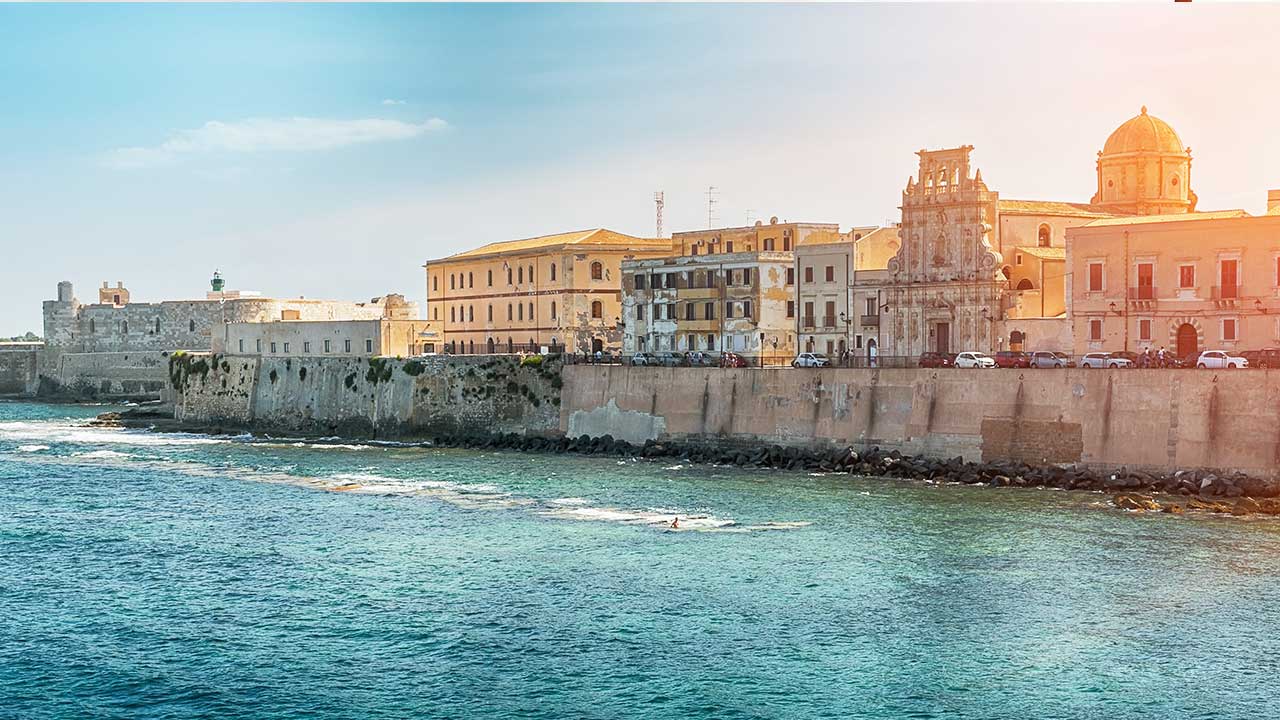
Syracuse sits nestled in the corner of the island of Sicily in the Ionian Sea. The birthplace of the celebrated mathematician and inventor Archimedes, the 2,700-year-old city played a key role in ancient times as a major power in the Mediterranean world. Once described by the Roman poet Cicero as “the greatest Greek city and the most beautiful of them all,” Syracuse is defined by its rich Greek and Roman history, culture, and architecture. The Archaeological Park Neapolis boasts the Roman Amphitheater, the Teatro Greco, and the Orecchio di Dionisio, a limestone cave that resembles the shape of a human ear. The Museo Archeologico Regionale Paolo Orsi displays terracotta artifacts, Roman portraits, and Old Testament scenes carved into white marble. Syracuse is your gateway to the UNESCO-awarded Baroque city of Noto and the Catacombs of San Giovanni.
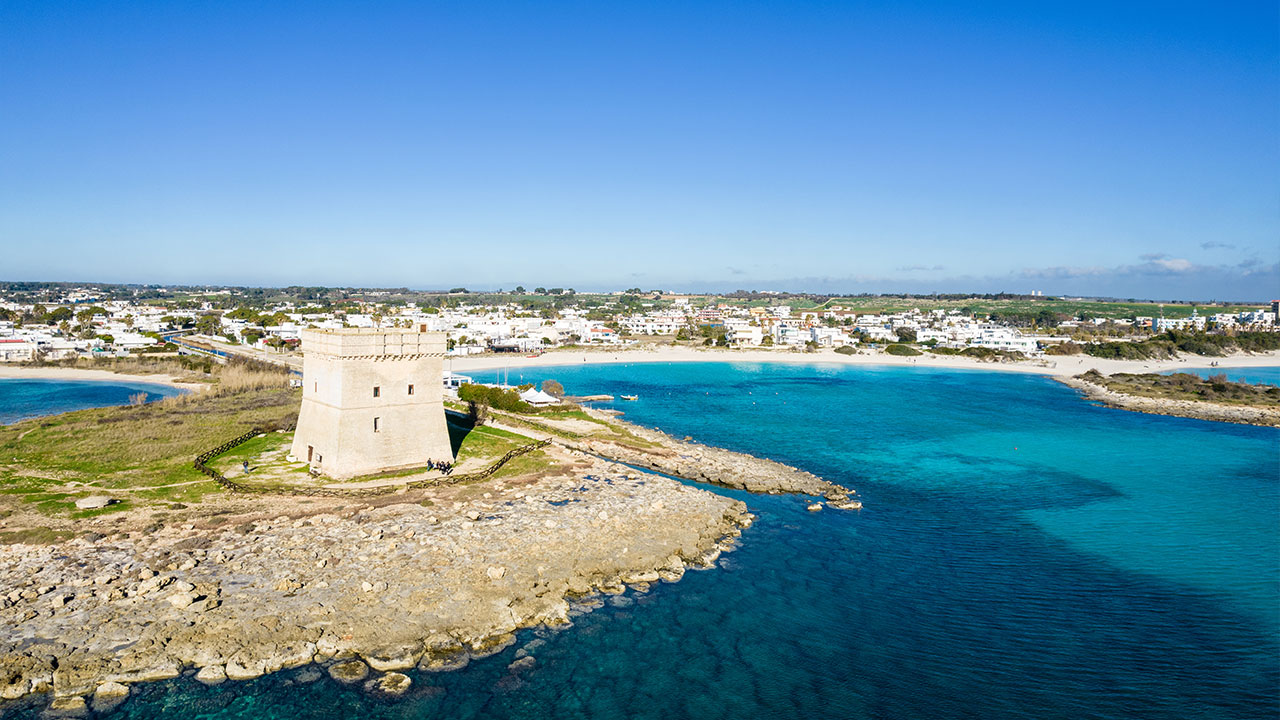
SeaDream yachts the Gulf of Squillace, a sheltered inlet along the Calabrian coast of Italy. It’s here that we plan to take full advantage of this breathtakingly beautiful area with Marina Days that invite you to swim, relax, or play with your choice of watersports toys in the tranquil azure waters of the Mediterranean. Slide into the sea on our new waterslide, the first and only on a cruise passenger vessel to take you from ship to sea. Swim and snorkel off your yacht, and enjoy complimentary catamarans, kayaks, paddleboards, jet skis, banana boats, and more.
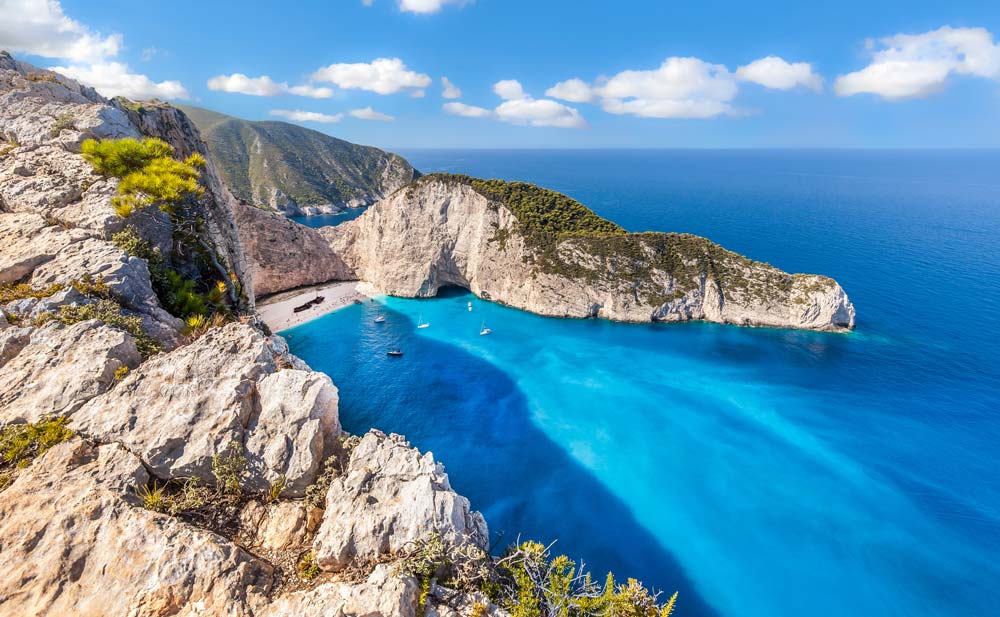
Nestled in the Ionian Sea, the island of Zakynthos is named after the son of a legendary Arcadian chief and a son of Zeus, Dardanus. The Venetians nicknamed the island “the Flower of the East,” as it boasts many beautiful beaches and rich vegetation with agricultural products such as citrus fruit, olive oil, grapes, and currants. As with other Greek islands, the culture and history of Zakynthos is extensive, dating to the Old Stone Age. Oldest mentions of the island date to the Mycenaean period, and ancient Greek poet Homer included Zakynthos in his famous works, The Odyssey and The Iliad. The island is well known as an iconic diving spot and for Navagio Beach, whose name comes from a famous shipwreck in 1980. Enjoy Porto Limnionas Beach, Blue Caves, Keri Caves, Turtle Island, Banana Beach, and the endangered Loggerhead Sea Turtle habitat in the Zakynthos Marine Park of Laganas Bay. A rich culinary tradition and wine culture can be found on the island: thicker sauces accompany dishes that incorporate more poultry and meat than other Greek cuisine. Comoutos Winery is one of the oldest running wineries, established in 1638, and the island’s most famous wine, Verdea, is one of the only two wines in Greece under the PGI Category. Guests are welcome to explore the Venetian castle on Bochali Hill, providing a panoramic view of Zakynthos Town; the Church of St. Nicholas, and St. Dionysios Cathedral.

Galaxidi is a small village on the northern coast of the Corinth Golf lying west of Itea and 15 km southwest of Delphi. It allows excellent access to the incredible sight of Delphi which is within the top three archeological attractions in Greece and in 1987 was inscribed as a UNESCO Heritage Site. It is believed the Zeus wanted to find the center of the Earth so he sent two eagles flying from the eastern and western extremities and where they met was Delphi – becoming the “navel/center of the earth”. SeaDream has arranged the very best guides and vehicles from Athens to further enhance this incredible visit. Your guided visit highlights the ancient Sanctuary of Apollo, where Pythia, the celebrated Oracle dwelt, the Temple of Apollo, the Sacred Way, the amphitheater, the best-preserved stadium of Greece, and the Castalia Spring, where in ancient days the pilgrims had to wash before they were allowed to consult the Oracle. In the Delphi Museum, see such treasures as the Omphalos, which marked the center of the world, and the magnificent bronze Charioteer, one of the finest pieces surviving from the 5th century BC. After the museum, there will be free time to visit the village of Delphi. SeaDream has the option of docking along the small pier in Itea or anchoring off to provide water sports options. This is dependent on availability as well as a number of guests visiting the archeological site.

So narrow! So dramatic! You'll understand why SeaDream says "expect the unexpected" as your yacht transits the Corinth Canal. The canal was first completed in 1893, despite previous attempts from ancient times; the first plans being from 602BC. The Roman Emporer Nero actually started construction in 67AD, making the first cut himself with a golden pick. The canal we transit is 6.3 kilometres (3.9 mi) in length. Before the canal, ships sailing between the Aegean and the Adriatic had to circumnavigate the Peloponnese Peninsula adding about 185 nautical miles to their voyage.
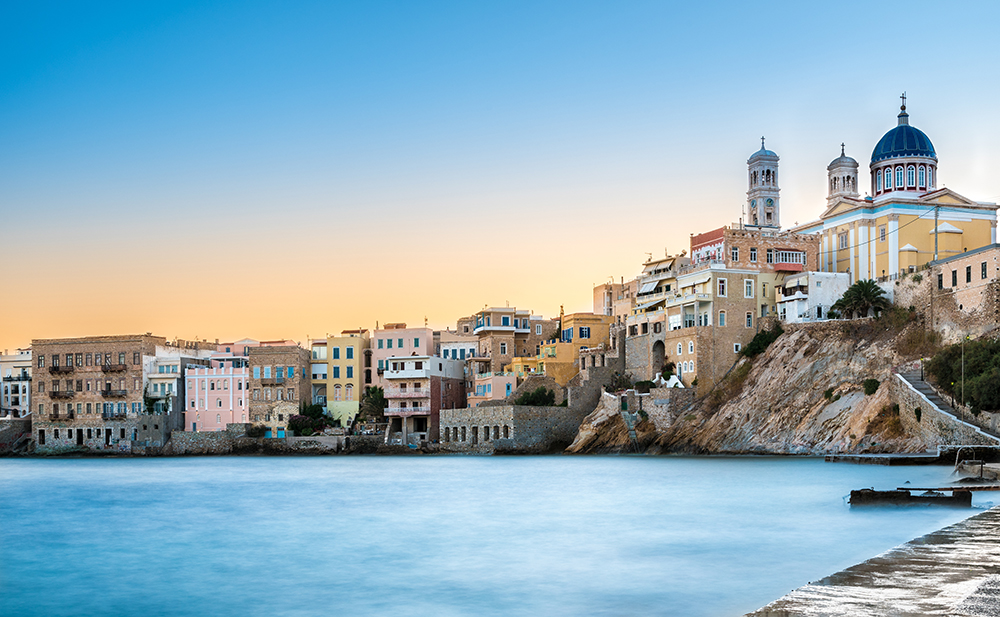
The small island of Syros offers the quintessential Greek island holiday experience without the crowds often found in the more well-known Greek Isles. With pristine blue waters, Syros’ breathtaking beaches are sure to impress. Kini, Vari, Azolimnos and Yalissás Beach are among its most famous options to bask in the sun. Beyond its beautiful beaches, Syros is part of the Cyclades, an island group in the Aegean Sea, and is filled with culture and history. The island is also commonly recognized for its Aegean cuisine which features several local specialties, making Syros a culinary destination.
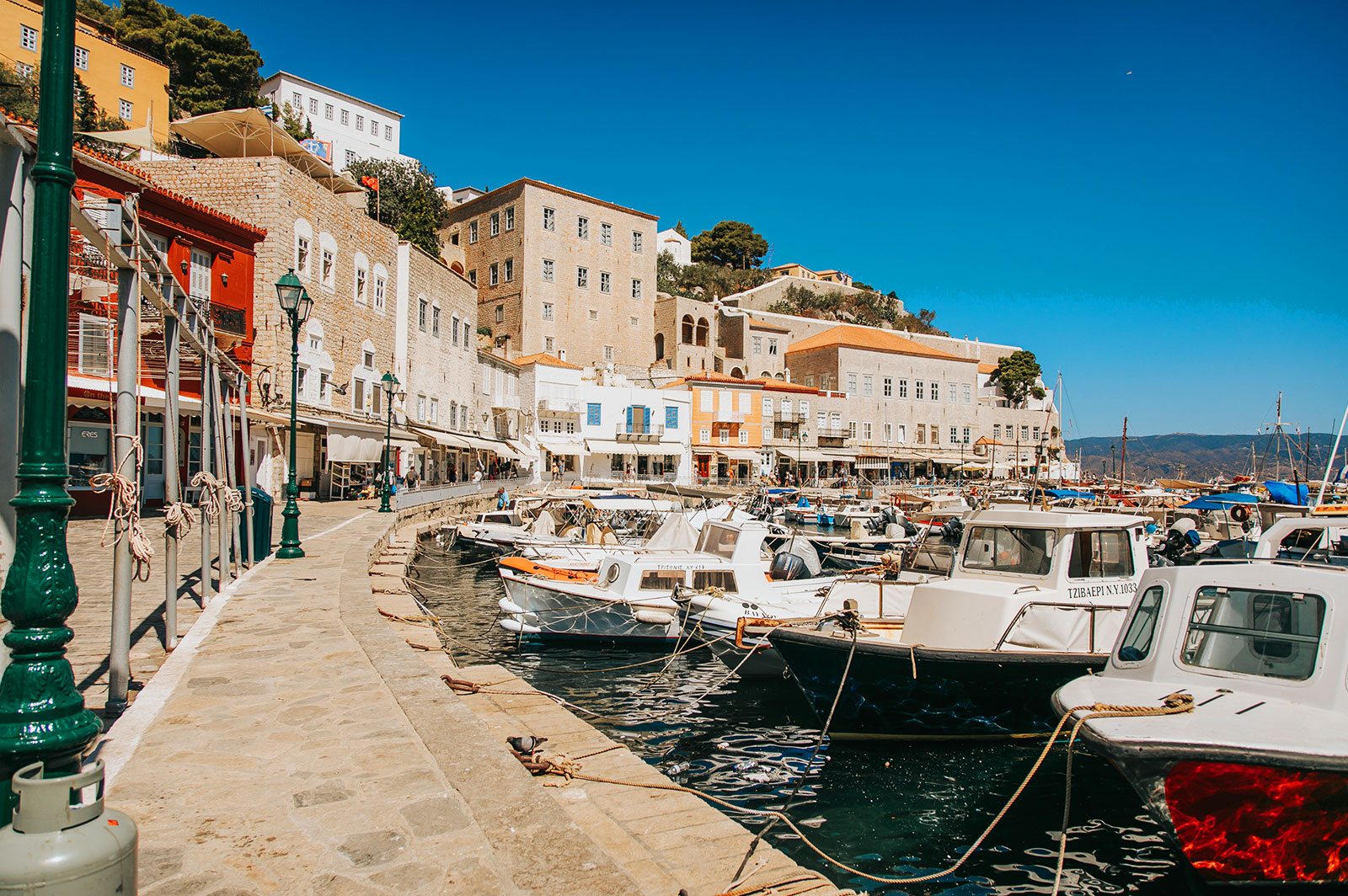
There is one main town on Hydra, known simply as "Hydra port". It consists of a crescent-shaped harbor, around which is centered a strand of restaurants, shops, markets, and galleries that cater to tourists and locals (Hydriots). Steep stone streets lead up and outwards from the harbor area. The charm of Hydra town certainly lies in her rich history, beautiful port and waterfront unspoiled by motorized vehicles. The island offers a rugged charm and some spectacular scenes and makes the perfect place for some self-exploration.

Piraeus, roughly translating to “the place over the passage”, is an important Greek port located within the Athens agglomeration, in the Attica Basin. It is 12 kilometers from the municipality of Athens, considered the fourth largest and is the third most populous amongst all the municipalities of Greece. Now a peninsula, Piraeus, originally a rocky island, was developed in early 5th Century B.C. when it was initially designated as Athens’ import and transit trade port. It is the largest marine-based shipping center of Greece, one of the largest ports in Europe, and considered the second largest passenger port in the world. Inhabited since the 26th Century, it wasn’t until the 6th Century B.C. that Piraeus began catching attention. The land of Piraeus was essentially impassable, flooded by the sea most of the year until centuries passed and the flooding ceased. By the 5th Century B.C. it became a navy base for the Athenian fleet for the natural harbors and the strategic potential they carried. Athenian general and politician Themistocles fortified Piraeus’ three harbors Kantharos, Zea and Munichia, created ship houses and completed his walls in 471 B.C., which led to the port becoming a great military and commercial harbor. There are many archaeological sites, points of interest and entertainment available in Piraeus. Most famous for its tavernas and cuisine, several popular events take place in Piraeus, such as the Ecocinema International Film Festival, the Maritime Festival, the Piraeus Rock Wave Festival and the Three Kings’ Way Festival. There are also many theaters, including the Municipal Theater, the open air Veakeio Theater, and the Menandreio Theater. Museums in Piraeus include the Archaeological Museum of Piraeus, the Merchant Shipping History Institute Exhibition, the Panos Aravantinos Decor Museum, the Georgios Averof Museum Ship and the Museum of Electric Railways. Be sure to catch the panoramic views available from the hill of Kastella, overlooking Athens and the Saronic Gulf!
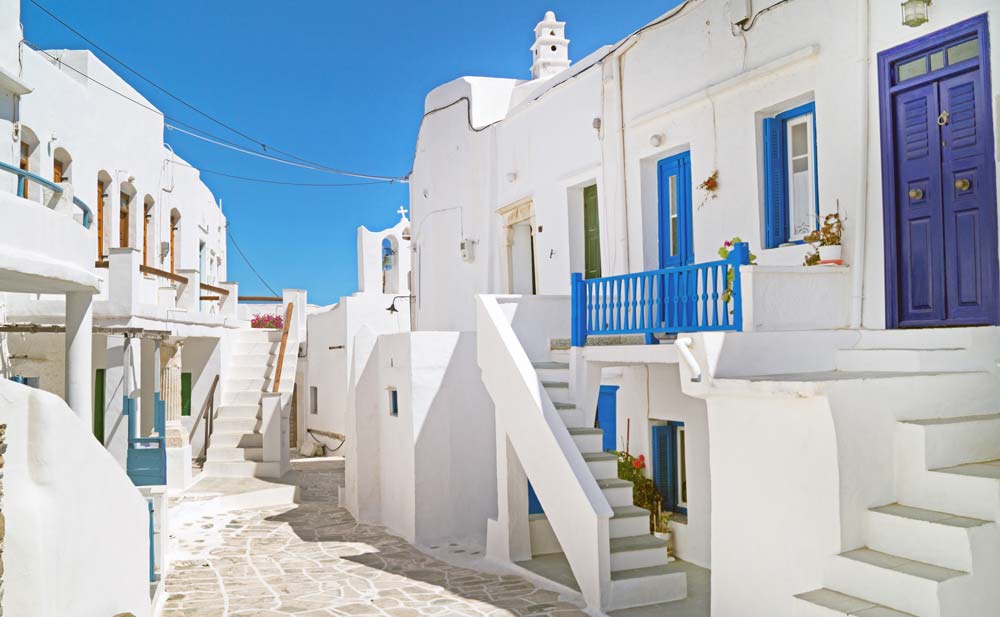
This Greek Isle's history dates back before the year 4000 BC. The island has a rich history of silver and lead mining and was one of the first places where currency minting occurred in Greece. Today, the island is frequented for its beaches, churches, festivals, food, and of course, classic Greek isle architecture.

A Greek island in the Cyclades group in the Aegean Sea, Ios lies halfway between Naxos and Santorini. A hilly island with cliffs down to the sea on most sides, Ios shines for its amazing beaches, shimmering waters, and picturesque clifftop villages with narrow alleyways. Assessable by ferry or yacht, Ios is within hand’s reach of several Greek islands, including Mykonos, Naxos, Paros, and Crete. Ancient sites, museums, windmills, and churches dot the island, most notably the whitewashed church of Panagia Gremiotissa above Chora, the tomb of the Greek poet Homer in Plakoto, and the early Bronze Age settlement of Sharkos. The Archaeological Museum of Ios, displaying findings unearthed on the island, is housed in the Amiradakio Hall, located in the center of Chora.

Santorini, officially named Thira, is the southernmost Greek island that is within the Cyclades archipelago, in the southern Aegean Sea. Part of the regional unit Thira, the municipality of Santorini is comprised of the island Santorini, Therasia, and other uninhabited islands of Christiana, Palaia Kameni, Aspronisi, and Nea Kameni. The geological history of Santorini is quite complex due to the area’s volcanism and is currently a water-filled caldera: a rectangular lagoon that is surrounded by three steep cliffs. The name Santorini is a contraction of the name Santa Irini, which is based on an ancient cathedral found in the island’s village of Perissa. This name was given by the Latin Empire in the 13th Century. During the Ottoman Empire, Santorini was called “Santurin” or “Santoron”, and in early times, it was named Kalliste, Strongyle, and Thera. Santorini is the site of the Minoan Eruption (also known as the Thera Eruption), one of the largest eruptions ever in recorded history. The origins of Plato’s story of Atlantis is believed to have a connection to this eruption that destroyed the early settlements on what was formerly a single island. The descriptions found of Plato’s Atlantis strongly resembles Thera, and with seismological, archaeological, and volcanological evidence, these claims are further supported. There is also speculation that the eruption is related to the Exodus of the Israelites, as well as causing the plagues described in the Bible in ancient Egypt. The economy is sustained by two principal industries: tourism and agriculture, and has recently been voted as one of the world’s most beautiful islands in various outlets such as the Traveler’s Choice Awards in 2015. The wine industry in Santorini is becoming more relevant as well, made up of Assyrtiko, Athiri and Aidani grape varieties, which is best exemplified in Vinsanto (“holy wine”) which contains all three Aegean varietals. Although Santorini is highly arid, it’s unique ecology and climate allows it to grow unique and prized produce, such as cherry tomatoes, Lathyrus clymenum (a legume), and capers. Thus, tourists indulge in local specialties such as Brantada, Fava, and the traditional dish Santorinio Sfougato.

Nestled in Turkey’s Aegean Sea, sits Çesme, a coastal resort town on the tip of the Cesme peninsula that shines for its natural beauty, sun-kissed beaches, sparkling sea, and rich history. The name Çesme means “fountain” in Turkish and is derived from the multiple sources of water found in the region. Overlooking the picturesque harbor is the restored military fortress Çeşme Castle, which today houses the Çeşme Archaeology Museum. On Çeşme peninsula’s east side is sandy Ilica Beach, its warm thermal sulfur springs welcoming travelers.

Kusadasi is a beach resort town on Turkey’s Aegean coast and the center of the seaside district of the same name in Aydin Province. The seaside town is also your gateway to the classical ruins at nearby Ephesus, among the world’s best preserved ancient Greco-Roman remains, including its excavated Terrace Houses and House of the Virgin Mary. Kusadasi’s seafront promenade, marina, and harbor are lined with quaint restaurants. Just offshore on Pigeon Island stands a walled thirteenth-century Byzantine castle that once guarded the town. Meet resident wild boars at nearby Dikek National Park, comprised of four secluded beaches, a spectacular coastline, and incomparable views of the Aegean Sea, just one of Turkey’s many protected conservation areas.

Patmos is in the South Aegean Islands, particularly a member of the Dodecanese Islands of Greece. It is north of Leros and is most known for its connection to John the Apostle from the Book of Revelations; therefore Christian pilgrims frequent this destination. In mythology, Patmos was named “Letois”, which is another named for the goddess Diana, Leto’s daughter. Since ancient authors seldom mention Patmos in early text, information on early inhabitants is limited. It is widely believed the original people of Patmos were the Carians from Asia Minor, as discovered by the earliest archaeological findings date back to the Bronze and Mycenaean periods. The mountain in the country of Caria was named Latmos, which is where historians believe the name Patmos is derived from. Dorians also colonized in Patmos, and over time, Ionians followed suit. The primary port in Patmos is Skala, which was one of the most important sea ports in the Mediterranean around the 16th century. Early Christian basilicas were constructed in the name of John of Patmos, however between the 7th and 9th century when Saracen attacks were still problematic, the Grand Royal Basilica was destroyed. A monastery began construction in 1101 when Christodoulos assumed authority over Patmos. The population began expanding as immigrants from the fall of Constantinople and Candia to place in the 15th and 17th centuries, respectively. The island was under the Ottoman rule for years and was interrupted by Venice during the Candian War, Russia during the Orlov Revolt, and Greece during their War of Independence. During the Italo-Turkish War, Italy occupied Patmos until 1943, when Nazi Germany held power over the island until 1945. Since Patmos rejoined in 1948, it has become the tranquil and frequented destination it is now. Tourists visit the Monastery of St. John, Chora, the Cave of Apocalypse, Psili Ammos Beach and other beautiful points of interest in “Europe’s most idyllic place to live,” as named by Forbes in 2009.

The scholar Cornelius Castoriadis called Tinos a “handmade island” for the stamp made by its signature marble-cutting artists, which elevated the island’s marble-carving tradition to new heights. As one of the Cyclades’ secret gems, Tinos offers nature lovers, art aficionados, and gastronomy enthusiasts diverse, rich experiences. Explore Tinos’ timeless treasures from Volax to Chora, delving into ancient landscapes and remarkable sites at every turn.
Suites & Staterooms
*Single Supplement for this voyage is 200% for Yacht Club Deck 2, 3 and 4. For Commodore, Admiral and Owners Suite, a 200% single supplement rate applies.
Government, Port, Document Issuance, Handling & Service fees: $1260 per guest (included)
Please Note: Fares are capacity controlled and may change without notice. The fares are per person based on double occupancy. Single and third person rates are also available. SeaDream Yacht Club strongly recommends that all guests purchase travel insurance.
Yachting Land Adventures & Activities
Pre-Book Online for 10% savings
Please check back soon for updates.
Testimonials
The ship is amazing but the icing on the cake was the wonderful staff. Mr & Mrs SouthonGreat Britain
Couples massage was one of the best I've ever had! Mr Hucker & Mrs BrunoFlorida
© 2025 SeaDream Yacht Club
